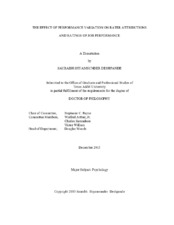| dc.description.abstract | In most organizations, employee performance is evaluated annually by their supervisors and these evaluations lead to important individual and organizational outcomes. Research has shown that properties of the performance distribution referred to as Gestalt characteristics (e.g., mean, variability) have a significant effect on performance ratings, as well as the attributions that raters make about ratee ability and motivation. This study extends previous research demonstrating the influence of Gestalt characteristics on performance ratings by examining the effect of two operationalizations of variability on performance ratings: tremors (short-term changes) and swells (longer-term changes). One hundred forty-eight participants participated in a 3 (mean: below average, above average, average) × 3 (swells: positive, negative, and none) × 2 (tremors: low, high) × 2 (rater locus of control: internal, external) mixed factorial experiment. Participants evaluated 18 hypothetical salespersons’ performance distributions and made attributions about the salesperson’s locus of causality, ability, and effort. Findings indicated that both tremors and swells had a significant effect on performance ratings, such that performance profiles with a high level of tremors were rated more favorably than profiles with a low level of tremors, and profiles with a positive/negative swell were rated significantly higher/lower than profiles without a swell. As predicted, tremors had a significant effect on rater attributions of effort such that raters attributed higher amounts of effort to performance profiles with a high level of tremors compared to profiles with a low level of tremors. Swells had a significant effect on rater attributions of ability as well as attributions of effort such that raters attributed positive swells to higher levels of ability and effort and negative swells to lower levels of ability and effort. Contrary to expectation, rater locus of control did not moderate the variability performance rating relationship. However, exploratory analyses revealed that rater locus of control moderated the relationship between swells and attributions of locus of causality, such that raters with an internal locus of control tended to attribute swells internally rather than externally. Implications of these findings for performance management are discussed. | en |


